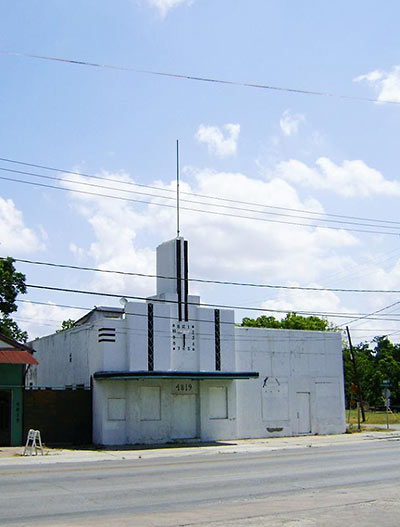
All that uproar over the impending demolition of a favorite Streamline Moderne structure in Eastwood seems to have had an effect: Houston architect Sol R. Slaughter’s 1935 Sterling Laundry & Cleaning Company building at 4819 Harrisburg will be preserved!
Sort of. Metro has committed to saving the façade.
Well . . . maybe at least the center part of it.
Okay really, just the top part, above the door. The part with the clock.
Hey, at least it’s not going to go away!
. . . ?
Uh, well . . . architectural antique fan Spencer Howard, who helped sound the alarm about Metro’s demolition plans for the building a few weeks ago, writes in with the latest:
Deconstruction will begin in two weeks, at which point the façade will be placed in storage (yet to be located) until the permanent home is designed (yet to be funded).
But the face-saving fun doesn’t stop there. After a short but brilliant week of investigations, brainstorming, and Photoshop work, Metro has produced a series of proposals for the rescued stretch of stucco that’s likely to be studied and appreciated by historic preservation experts, redevelopment advocates, and postmodern philosophers for some time to come.
Monday’s presentation at the offices of the Greater East End Management District was simply titled “4819 Harrisburg,” but that’s just Metro being modest. Maybe when this thing is resurrected for academic conferences it can be called something like “Representations of Time: Practical Opportunities in Deconstruction and Preservation.”
***
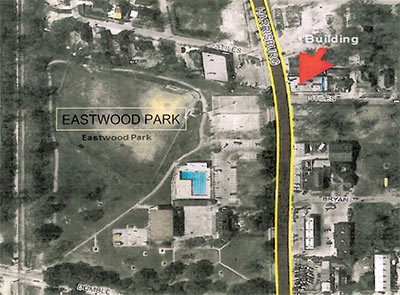
First, the problem. Howard explains:
Unfortunately, the building is located across from a city park and current laws prevent the transit authority from taking park land for the new light rail line. This puts the new right-of-way line just behind the current facade location and in order to save any part of the building the facade must be moved.
Working on a solution, Metro workers first contemplate the temporal nature of building itself:
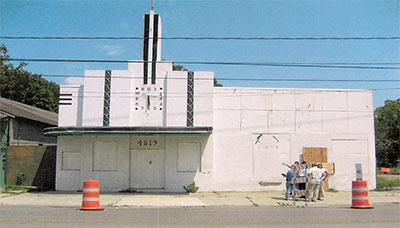
What parts of the past can be preserved? How about . . . just the timepiece itself!
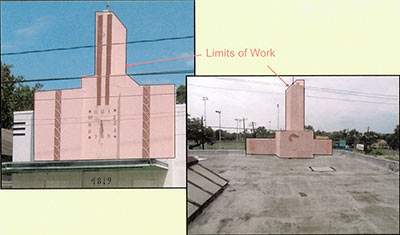
Metro’s first photo-illustration shows the building site turned into a new but temporary pocket park — across the street from Eastwood Park. A new replica of the preserved façade portion is placed in the park, set back from the street. Metro labels this proposal the “Interim Onsite Façade Replica.”
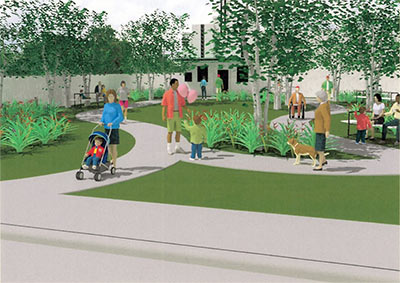
Topics for discussion: duplication (building and park), simulation, replacement, limited preservation horizon, spectacle.
But what should happen to the actual façade?

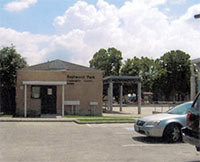 Metro’s relocation option one: The façade gets reused as . . . a façade! It goes in front of the existing Eastwood Park Community Center building across the street.
Metro’s relocation option one: The façade gets reused as . . . a façade! It goes in front of the existing Eastwood Park Community Center building across the street.
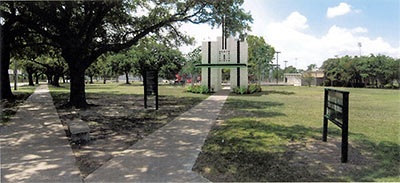
Option two: The preserved façade becomes Eastwood Park’s very own mini Arc de Triomphe, celebrating the victory of time over the forces that wish to prevent its passage. No mention of whether the grave of one of former resident William Steen’s unknown graffiti artists will be located underneath.
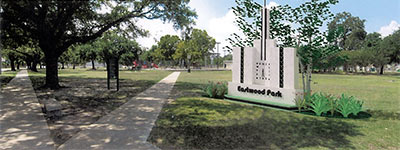
Option three: A monument to time becomes a monument. Or rather, the cleaners clock is used as a new monument sign for Eastwood Park itself. Design experts will appreciate the provocatively subversive use of a popular late-1960s-era typeface on the preserved art-deco-era timepiece.
Question for discussion: Should passers-by be able to reset or adjust time?
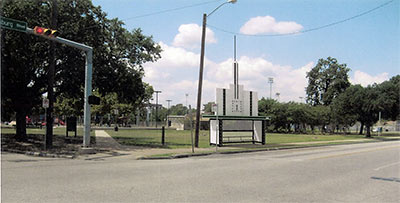
Option four: Here the metaphors start getting even more complex. The clock face, displaced by fixed-rail transit, seeks more free-form expression with an alternate form of transportation around the corner. At . . . a bus stop! But when will the bus arrive? Passengers will be presented with an apt and thought-provoking dilemma, as they will be unable to see what time it is while they stand under the shelter.
Topic for discussion: Should the clock be set to tell the time accurately? What would be the implications?
Other thought-provoking proposals not included in Metro’s presentation: Manufacturing and selling Sterling Cleaners clock replica watches to raise funds for area civic groups. Or another no-build option: Silent, daily Eastwood commemorations of the building at the time of its final rest, which appears to be sometime around 6:30.
- 4819 Harrisburg Update [Architectural Antique Review]
- Art Deco Slaughter on Harrisburg: Is Metro Taking To the Cleaners? [Swamplot]
Photos: Patrick Feller (top; license); Metro, via Spencer Howard (all others)


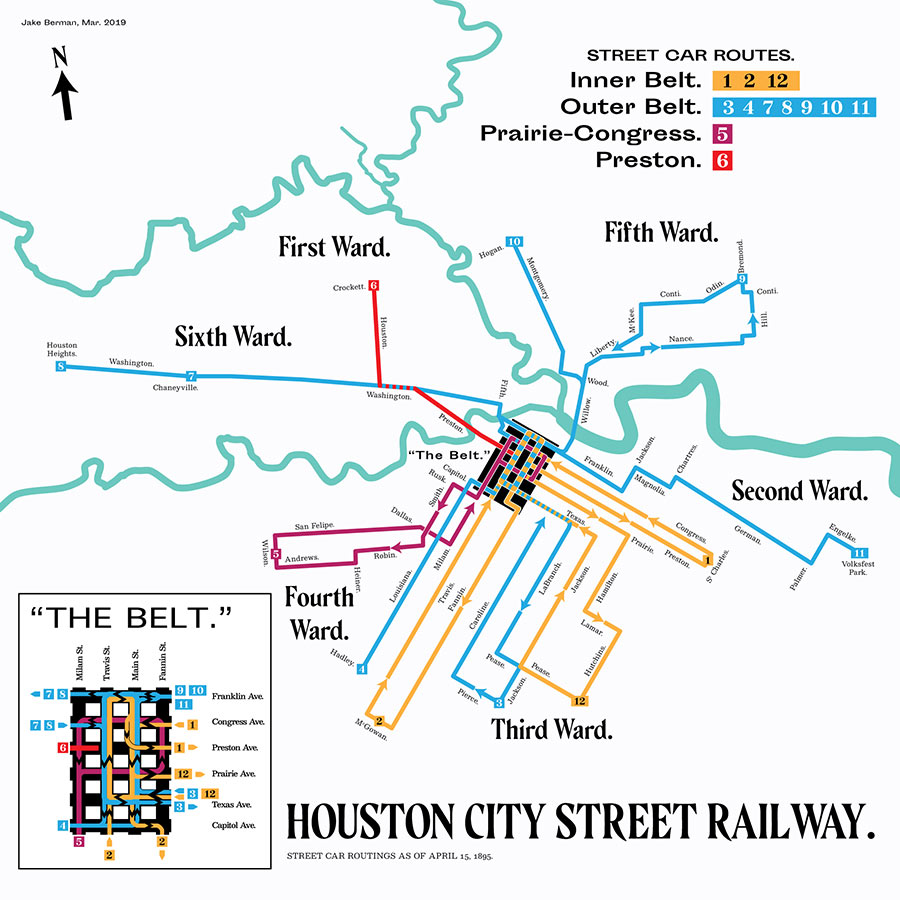


HAHA! This is actually funny (yet sad) that METRO had to spend a bunch of money figuring out what to do with it.
As long as it’s saved and someone who wants it gets it in their possession, I’m fine. Why go through all the trouble of figuring out how to re-use it.
Can the same thing be done for the River Oaks Theatre and the Bookstop facades?
Oy!
I’m not a fan of this sort of tokenism. What a let-down!
One could also recreate the building’s facade in trompe l’oeil anywhere in the city! Like is done around the courthouse square in Huntsville.
This was a well written piece. Love the sarcasm! I guess they couldn’t find an art deco font in PhotoShop? I can’t believe they’re serious about some of these ideas. Just one more reason Metro can suck it.
Given the pressure on Metro, I like the Community Center facade idea. Looking at the rendering, I would certainly delete the giant on-building signage. Instead, put that info on a modest adjacent sign. I’ve noticed this building many times. I think saving the notable part of the structure and attractively reusing it across the street is a win-win.
You know, I am surprised at myself, but I find the “Arc d’Triomphe” treatment kind of fabulous.
This seems like a wasted effort. I’m all for architectural salvage and historic preservation, but taking a small piece of an interesting urban building and re-deploying it in a suburban park-like setting causes it to lose much of its architectural meaning.
Total bulls**t. To expound on another posters comment, this type of “preservation” smacks of tokenism… nothing more. The real irony is that Metro’s actual proposal is more of a parody than the snarky commentary following the images.
I’ve always felt that it’s better to live with a memory of what was (i.e. integrity intact), than to sully what is through a misguided, half hearted effort to appease (i.e. integrity squandered).
This situation presents an actual dilemma — both choices (demolish in total or snip off a vestige) are unsatisfactory. So the question is: Which of the two is less so?
What a waste of time and energy.
Snipping off a vestige is less so.
There are more than just two options (that we relocate the facade and strip it of its artistic integrity, or that we demolish it).
.
For the price of meticulously deconstructing it, storing it indefinitely, and ultimately (maybe) reconstructing it, we could commit contemporary design principles (to modern building materials, as they should be) to designing a completely new artistic expression, one that is neither a half-hearted attempt at some ill-defined goal or that sullies the meaning or memory of Sterling Laundry, but which has a purpose that is an end in itself.
With respect to comments from “TheNiche” — fair enough. An entirely new expression is preferred over the inevitable demolition and especially the memorialized vestige approach.
Well, I guess “tear it down and replace it with something new and cool” is better than “tear it down and replace it with something cheap and bad,” or “tear it down and replace it with a vacant lot,” which seems to be the usual Houston way.
But I thought the whole point of this is to get the structure out of the way of the train, and preserve at least some of the spirit of the original structure. How does TheNiche’s proposal do that? It sounds like just a lofty way of saying “Out with the old, in with the new, so it is and so it shall always be.”
marmer, “the point of this” is for METRO and a handful of local politicians to try and buy good publicity by throwing a bone to preservationists. Make no mistake about that.
.
What I’m trying to say is: Don’t bastardize good art and don’t take historical artifacts out of their context lest they lose their inherent meaning and significance. If there are funds available to expensively bastardize it, then forgo the bastardization and instead build something with artistic integrity such as properly reflects its context.
.
It’ll be old and historical one day, too, and yes, we might have to tear it down again some day for some reason…so what?
You’d think I’d learn after all these years — don’t argue with TheNiche! ;-)
“marmer, “the point of this†is for METRO and a handful of local politicians to try and buy good publicity by throwing a bone to preservationists. Make no mistake about that.”
I completely agree, and I doubt anyone seriously disagrees with that.
“What I’m trying to say is: Don’t bastardize good art and don’t take historical artifacts out of their context lest they lose their inherent meaning and significance. If there are funds available to expensively bastardize it, then forgo the bastardization and instead build something with artistic integrity such as properly reflects its context.”
This is what I’m having trouble understanding. It sounds like you’re proposing building something completely new with design integrity and sensitivity to context. Of course those are excellent ideals, but in this case to what purpose? The money is intended to preserve at least some of the original design somewhere in the original area. Is there a need for a small building like that in the rail vicinity? My guess is, probably not, or the Laundry building would already be occupied, maybe even moved and rehabilitated. Or are you saying that the money would be better spent making some other new project better, and an art deco “presence” or reminder ot the Laundry building (clock, pylon) of some kind in that area is just not worth it?
marmer said: “The money is intended to preserve at least some of the original design somewhere in the original area.”
.
No, as we’ve already established the money (or that part of it that has been appropriated) is intended to satisfy a political constituency, which does not necessarily entail a preservation effort if the constituency were convinced that something new, genuine, and contextually sensitive were superior to the expensive bastardization of magnificence.
.
marmer said: “Is there a need for a small building like that in the rail vicinity? My guess is, probably not, or the Laundry building would already be occupied, maybe even moved and rehabilitated.”
.
My understanding is that the owner had been using it as an art studio space. That seems like a pretty legitimate use to me.
.
To be clear, I am proposing either a building (if a developer can be found such as would be interested in a public/private partnership) or an elaborate sculpture. If it is a sculpture, then its purpose is entirely aesthetic in scope. In either case, I propose that the architecture reflect the context of the era and environment that it will impact, even if that requires the abandonment of an art deco theme.
.
I would be amenable to a plaque or some such commemoration.
TheNiche said:
.
marmer said: “Is there a need for a small building like that in the rail vicinity? My guess is, probably not, or the Laundry building would already be occupied, maybe even moved and rehabilitated.â€
.
My understanding is that the owner had been using it as an art studio space. That seems like a pretty legitimate use to me.
.
I know it had been an art studio for a long time but I thought it was vacant and boarded up, and had been for a while. Maybe just since METRO condemned it, I don’t know. I didn’t mean to imply that the art studio wasn’t legitimate.
They never really interacted with the street in the way that a retail user might. Art studios can often be like that. But yes, there was a user until METRO displaced the user.
There are a number of small buildings in the East End that could be purchased with the proceeds from eminent domain, so there is not much incentive to bother with the expensive process of moving the building.
Well it ain’t Pennsylvania Station, but why not use the façade as a ….façade? It’s not like the original elevation was specific to laundries, it’s abstract, a fine doorway presented in a graphic well proportioned way. I like the use on the community center. I don’t see the problem in moving the façade – it isn’t a shrine.
We’re splitting hairs here… the dialog has moved from preservation to an academic mano e mano on what should be done. I’ll renege on my previously concurrence that a third option is possible: Replacement with an interpretation of the original. Such is “the usual Houston Way†as suggested by “marmer†is valid and of course, accurate. Given the choices, the best course of action – the one in which the most integrity of the original edifice is maintained – is demolition in total.
Anything else is nothing more than pastiche.